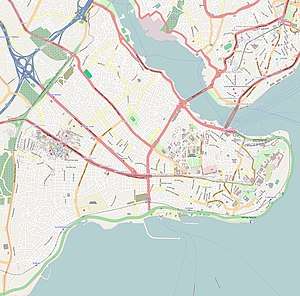Laleli Mosque
The Laleli Mosque (Turkish: Laleli Camii, or Tulip Mosque) is an 18th-century Ottoman imperial mosque located in Laleli, Fatih, Istanbul, Turkey.[1]
| Laleli Mosque | |
|---|---|
Laleli Mosque exterior | |
| Religion | |
| Affiliation | Sunni Islam |
| Location | |
| Location | Istanbul, Turkey |
 Location within the Fatih district of Istanbul | |
| Geographic coordinates | 41°00′36″N 28°57′24″E |
| Architecture | |
| Architect(s) | Mehmet Tahir Ağa |
| Type | mosque |
| Style | Baroque |
| Groundbreaking | 1760 |
| Completed | 1783 |
| Specifications | |
| Dome height (outer) | 24.5 metres (80 feet) |
| Dome dia. (outer) | 12.5 metres (41 feet) |
| Minaret(s) | 2 |
| Materials | granite, marble |
History
The Laleli Mosque was built by Sultan Mustafa III from 1760–1763, designed in the baroque style by Ottoman imperial architect Mehmet Tahir Ağa.[2]
The complex was destroyed by a fire in 1783 shortly after its completion and was immediately rebuilt. A fire in 1911 destroyed the madrasah, and subsequent road construction work destroyed many other auxiliary structures to the mosque.
Exterior
The mosque was built on a high terrace over a complex of vaulted shops, whose rents were intended to financially support the mosque complex. Underneath the mosque structure itself is a great hall, supported by eight enormous pillars with a fountain in the center.[3]
The mosque is oriented along a northwest-southeast axis, and has a rectangular courtyard about twice the size of the prayer hall to the northwest. This courtyard has a continuous arcade with eighteen domed bays and an ablution fountain in the center. The mosque itself has a brick and masonry base, with a masonry superstructure and octagonal drum supporting the dome. There are two minarets located at either end of the portico flanking the courtyard entrances.
Interior
The Laleli Mosque is an octagon inscribed within a rectangle, with a gallery on its western end. The walls make use of colorful variegated marbles in red, blue, yellow and browns, further decorated with medallions in opus sectile using also semi-precious onyx and jaspers. The mihrab and mimbar are likewise richly decorated with precious marbles. The interior is well lit, with numerous windows in combinations of white and stained glass.
The dome is 12.50 metres (41.0 feet) in diameter and 24.50 metres (80.4 feet) high on an octagonal drum of eight arches, with semi-domes at the corner arches and larger semi-domes joining the arches above the mihrab and the central bay of the narthex.
Complex
Most of the structures of the Laleli Mosque kulliye have disappeared over the years, but octagonal domed türbe facing Ordu Street remains, and contains the graves of Mustafa III, his wife Mihrisah Sultan, son Selim III and daughters Hibetullah and Fatma Sultan and Mihrimah Sultan. The interior is decorated with İznik tiles, and a band of calligraphy encircles the upper walls.
The Tayyare Apartments were built in 1922 next to the mosque on the ground of 1911 burnt down Koska Madrasa, which belonged to the mosque's complex. The buildings were redeveloped into a five-star hotel.
Gallery
 General view
General view Interior view
Interior view Ritual fountain (şadırvan)
Ritual fountain (şadırvan) Laleli Mosque stairs to courtyard from the surrounding platform
Laleli Mosque stairs to courtyard from the surrounding platform Laleli Mosque view to courtyard with ablutions fountain
Laleli Mosque view to courtyard with ablutions fountain Laleli mosque from Ordu Caddesi
Laleli mosque from Ordu Caddesi Laleli Mosque tomb Sultan Mustafa III and son Selim III
Laleli Mosque tomb Sultan Mustafa III and son Selim III
Notes
- Laleli Complex Archived 2006-05-25 at the Wayback Machine. ArchNet
- Faroqhi, Subjects of the Sultan.
- Freely, Blue Guide Istanbul
References
| Wikimedia Commons has media related to Tulip Mosque (Istanbul). |
- Faroqhi, Suraiyah (2005). Subjects of the Sultan: Culture and Daily Life in the Ottoman Empire. I B Tauris. ISBN 1-85043-760-2.
- Freely, John (2000). Blue Guide Istanbul. W. W. Norton & Company. ISBN 0-393-32014-6.
- Goodwin, Godfrey. 1997 (reprint of 1971). A History of Ottoman Architecture. Thames and Hudson: London, 388-391.

